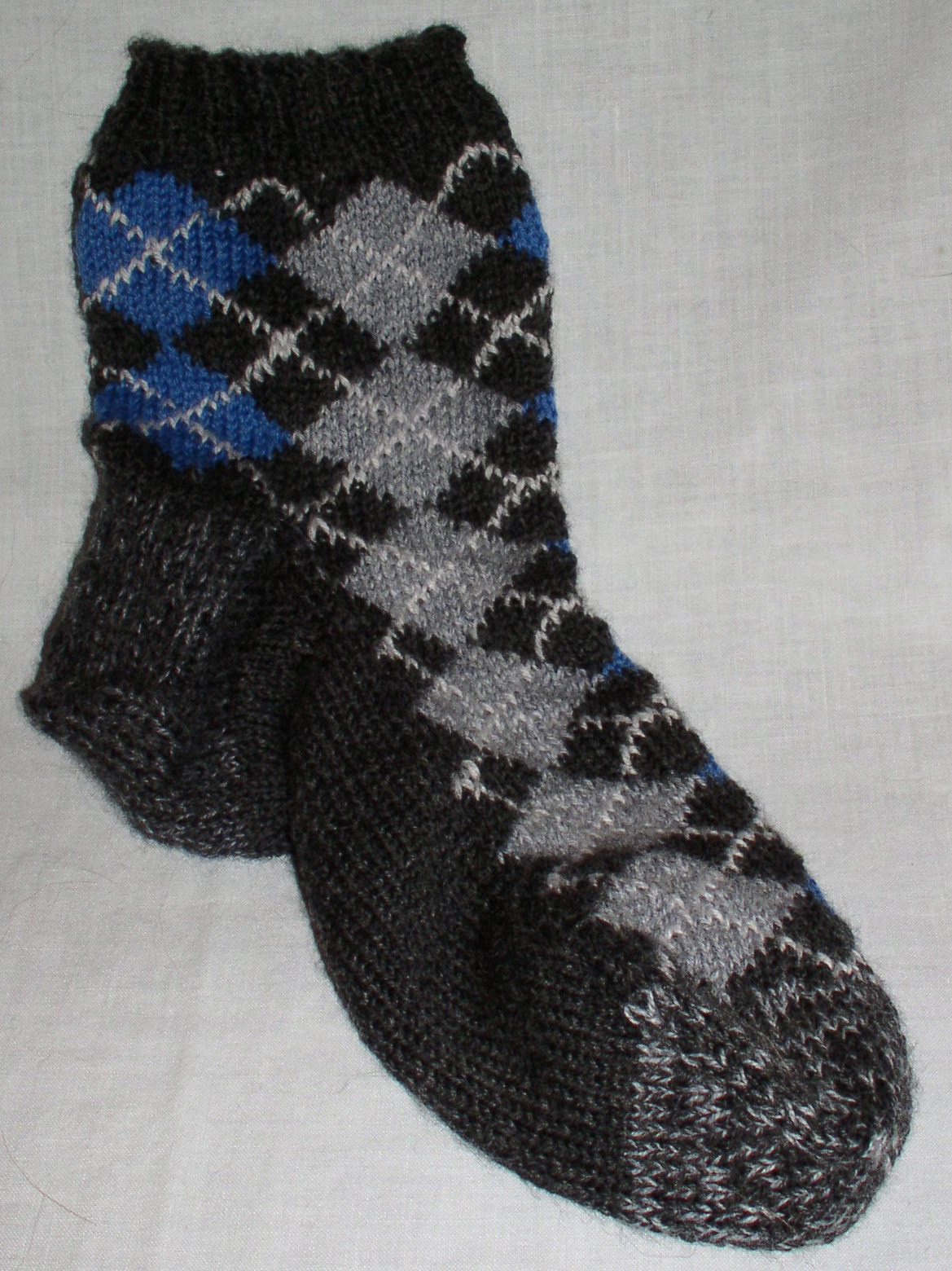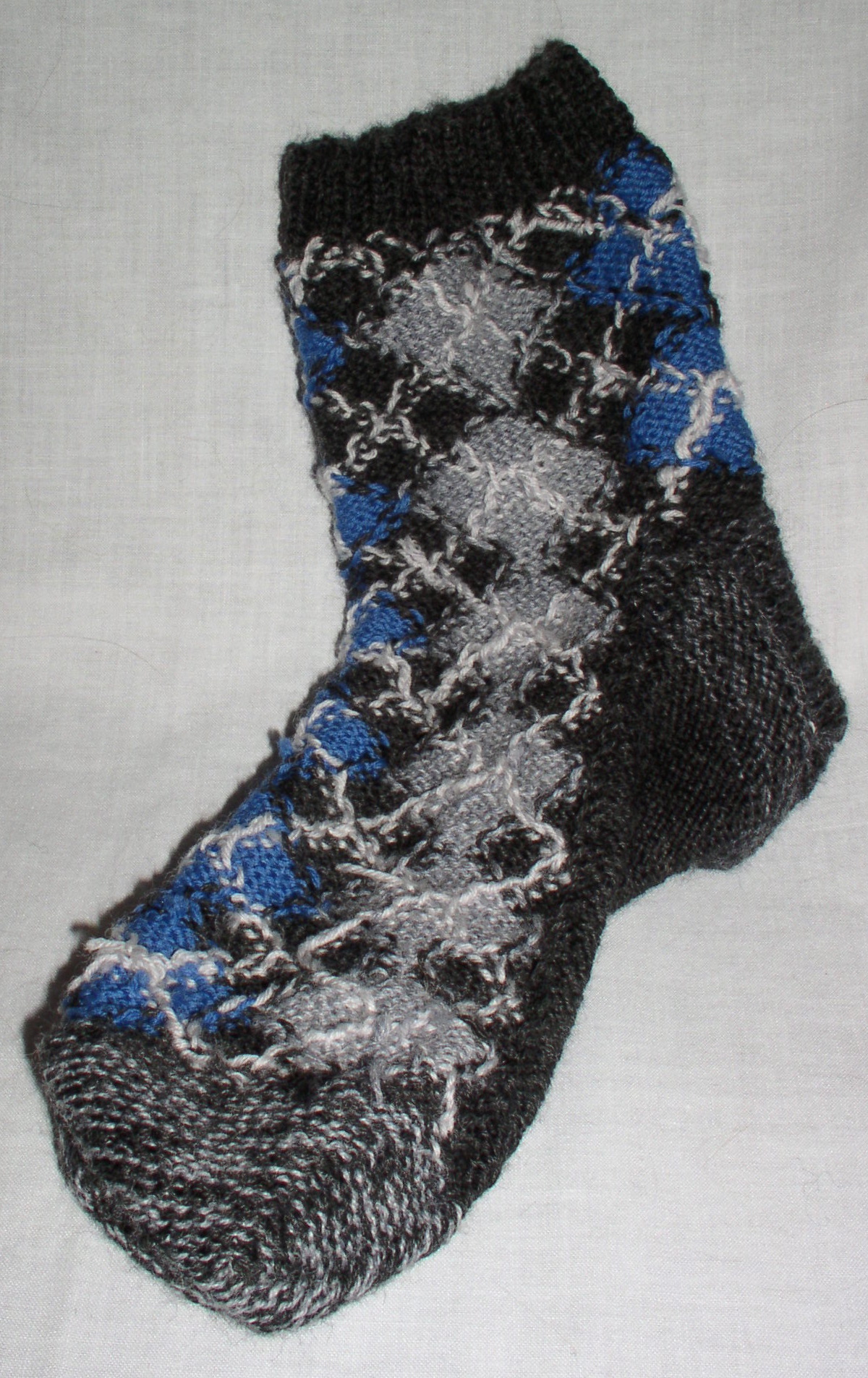Intarsia (knitting) on:
[Wikipedia]
[Google]
[Amazon]

 Intarsia is a
Intarsia is a
 Knitting in intarsia theoretically requires no additional skills beyond being generally comfortable with the basic knit and purl stitches. Materials required include multiple colours of yarn, standard needles, and ''bobbins''. Bobbins serve to contain the inactive yarn and help keep it from getting tangled. Unlike the narrow, wooden ones used to make bobbin lace, modern intarsia bobbins resemble translucent plastic
Knitting in intarsia theoretically requires no additional skills beyond being generally comfortable with the basic knit and purl stitches. Materials required include multiple colours of yarn, standard needles, and ''bobbins''. Bobbins serve to contain the inactive yarn and help keep it from getting tangled. Unlike the narrow, wooden ones used to make bobbin lace, modern intarsia bobbins resemble translucent plastic

 Intarsia is a
Intarsia is a knitting
Knitting is a method by which yarn is manipulated to create a textile, or fabric. It is used to create many types of garments. Knitting may be done by hand or by machine.
Knitting creates stitches: loops of yarn in a row, either flat or i ...
technique used to create patterns with multiple colours. As with the woodworking technique of the same name, fields of different colours and materials appear to be inlaid in one another, fit together like a jigsaw puzzle.
Unlike other multicolour techniques (including Fair Isle
Fair Isle (; sco, Fair Isle; non, Friðarey; gd, Fara) is an island in Shetland, in northern Scotland. It lies about halfway between mainland Shetland and Orkney. It is known for its bird observatory and a traditional style of knitting. Th ...
, slip-stitch colour, and double knitting
Double knitting is a form of hand knitting in which two fabrics are knitted simultaneously on one pair of needles. The fabrics may be inseparable, as in ''interlock knitted fabrics'', or they can simply be two unconnected fabrics. In principle, ...
), there is only one "active" colour on any given stitch, and yarn is not carried across the back of the work; when a colour changes on a given row, the old yarn is left hanging. This means that any intarsia piece is topologically several disjoint columns of colour; a simple blue circle on a white background involves one column of blue and two of white—one for the left and one for the right. Intarsia is most often worked flat
Flat or flats may refer to:
Architecture
* Flat (housing), an apartment in the United Kingdom, Ireland, Australia and other Commonwealth countries
Arts and entertainment
* Flat (music), a symbol () which denotes a lower pitch
* Flat (soldier), ...
, rather than in the round
A theatre in the round, arena theatre or central staging is a space for theatre in which the audience surrounds the stage.
Theatre-in-the-round was common in ancient theatre, particularly that of Greece and Rome, but was not widely explored ag ...
. However, it is possible to knit intarsia in circular knitting using particular techniques.
Common examples of intarsia include sweaters with large, solid-colour features like fruits, flowers, or geometric shapes. Argyle socks and sweaters are normally done in intarsia, although the thin diagonal lines are often overlaid in a later step, using Swiss darning
Swiss may refer to:
* the adjectival form of Switzerland
*Swiss people
Places
* Swiss, Missouri
*Swiss, North Carolina
* Swiss, West Virginia
*Swiss, Wisconsin
Other uses
* Swiss-system tournament, in various games and sports
*Swiss Internationa ...
or sometimes just a simple backstitch
Backstitch or ''back stitch'' and its variants ''stem stitch'', ''outline stitch'' and ''split stitch'' are a class of embroidery and sewing stitches in which individual stitches are made backward to the general direction of sewing. In embroid ...
.
Technique
 Knitting in intarsia theoretically requires no additional skills beyond being generally comfortable with the basic knit and purl stitches. Materials required include multiple colours of yarn, standard needles, and ''bobbins''. Bobbins serve to contain the inactive yarn and help keep it from getting tangled. Unlike the narrow, wooden ones used to make bobbin lace, modern intarsia bobbins resemble translucent plastic
Knitting in intarsia theoretically requires no additional skills beyond being generally comfortable with the basic knit and purl stitches. Materials required include multiple colours of yarn, standard needles, and ''bobbins''. Bobbins serve to contain the inactive yarn and help keep it from getting tangled. Unlike the narrow, wooden ones used to make bobbin lace, modern intarsia bobbins resemble translucent plastic yo-yo
A yo-yo (also spelled yoyo) is a toy consisting of an axle connected to two disks, and a string looped around the axle, similar to a spool. It is an ancient toy with proof of existence since 500 BCE. The yo-yo was also called a bandalore in ...
s that can snap tight to prevent the yarn from unwinding.
After winding a few yards of each colour onto its own bobbin (and possibly several bobbins' worth of some colours), the knitter simply begins knitting their pattern. When they arrive at a point where the colour changes, the knitter brings the new colour up underneath the old one (to prevent holes) and starts knitting with it. If flat knitting, at the end of the row, the piece is turned round just as with regular knitting, and the knitter returns the way they came.
The simplest intarsia pattern is for straight vertical stripes. After the first row, the pattern is continued by always working each stitch in the same colour as the previous row, changing colours at exactly the same point in each row. To make more elaborate patterns, one can let this colour boundary drift from row to row, changing colours a few stitches earlier or later each time.
Intarsia patterns are almost always given as charts (which, because of the mechanics of knitting, are read beginning at the lower right and continuing upward). The charts generally look like highly pixellated
In computer graphics, pixelation (or pixellation in British English) is caused by displaying a bitmap or a section of a bitmap at such a large size that individual pixels, small single-colored square display elements that comprise the bitmap, a ...
cartoon drawings, in this sense resembling dot-matrix computer graphics
Computer graphics deals with generating images with the aid of computers. Today, computer graphics is a core technology in digital photography, film, video games, cell phone and computer displays, and many specialized applications. A great de ...
or needlepoint
Needlepoint is a type of canvas work, a form of embroidery in which yarn is stitched through a stiff open weave canvas. Traditionally needlepoint designs completely cover the canvas. Although needlepoint may be worked in a variety of stitches, m ...
patterns (though usually without the colour nuance of the latter).
Knitting intarsia in the round
There are several techniques to execute intarsia when circular knitting. Executing intarsia "in-the-round" eliminates the need for seams and, in one case, turning the piece and working from the wrong side. Priscilla Gibson-Roberts discusses four techniques for knitting intarsia in the round in her book, ''Ethnic Socks & Stockings''.References
* * * *External links
* {{knitting Knitting ornaments